A variety of Short Treks in Nepal are available, like Everest Base Camp Trek, Annapurna Base Camp Trek, Mardi Himal Trek, Khopra Ridge Trek, and many more depending on your timeframe and preferences where you wanna trek in Nepal. In terms of trekking and tranquil natural beauty, Nepal is one of the most popular nations in the world. It is a land of fun and wonders, with a wide range of exciting activities to choose from in beautiful settings.
One of the most popular and appreciated among them is trekking. Travelers from all over the globe come to Nepal to enjoy the beautiful scenery and quiet routes while trekking. If you’re short on time, there’s a terrific place to go for short treks in Nepal with a spectacular view of mountain ranges. In Nepal, there are many different sorts of treks, each with its unique peculiarities and ambiance.
Short treks in Nepal last anywhere from three to ten days. These short treks in Nepal, however, afford a fantastic perspective of the majestic mountain ranges. Several lovely pathways provide a wonderful glimpse into the culture and history of the destination’s residents.
We’ll clear up any misconceptions regarding the various options for your next trek excursion in this post. The information in this post will aid you in choosing the ideal short treks in Nepal for you based on your preferences and resources. The 12 greatest short treks in Nepal are listed here.
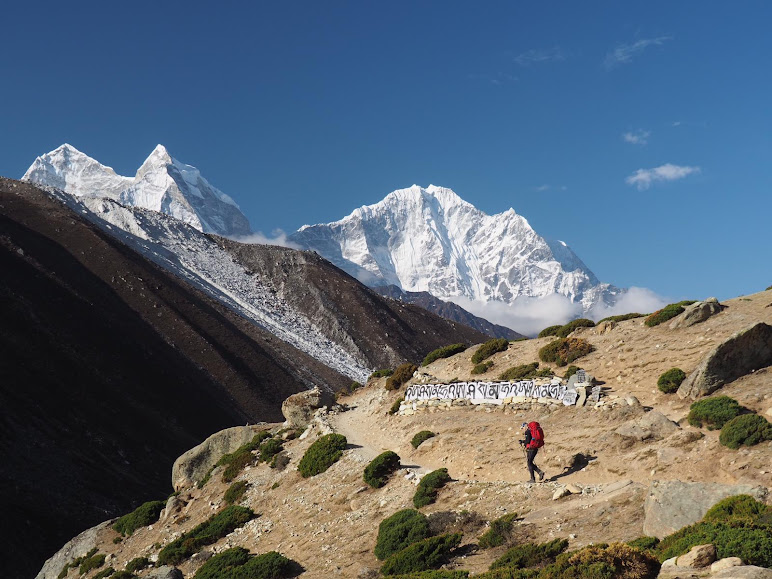
Everest Base Camp Trek
Besides all the different trekking spots in Nepal, Mount Everest is one of the highest peaks in the world where people are willing to trek. Everest Base Camp has been considered one of the premier mountain treks since the 60s. It has been considered one of the premier mountain treks since the day Nepal opened its doors to national and international trekkers. It can also be done in your short time frame by customizing your itinerary accordingly which makes it one of the top exciting short treks in Nepal.
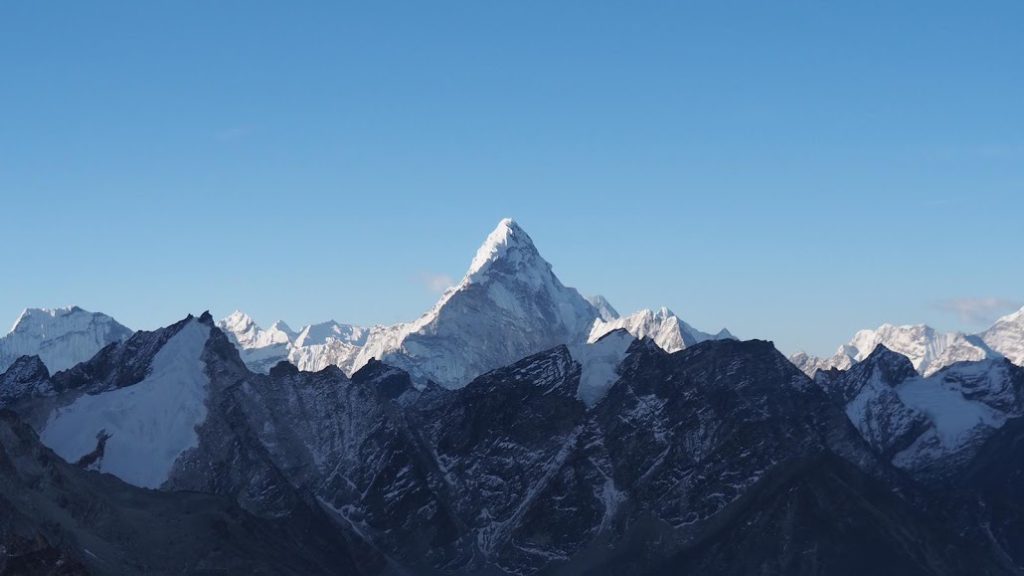
Highlights of Everest Base Camp Trek
- Sherpa Village/ Namche Bazar. Which is known as the heartland of Sherpa’s
- Flight to Lukla, where you can enjoy the mesmerizing views of the mountains.
- Enjoy and have a good time in Khumjung Village, which is one of the smallest monastery villages located above Namche Bazar
- Peaceful and Calm sound of the Dudhkoshi River
- Khumbu Glacier
Trek glance of Everest Base Camp Trek
- Arrival City: Kathmandu
- Departure City: Kathmandu
- Average Duration: 9 to 11 days
- Altitude: 5600 meters/ 17060 feet
What is the best season for Everest Base Camp Trek?
The greatest time to visit Everest Base Camp is on either side of the monsoon season, which runs from late May to mid-September. The primary trekking months are late September to November and February to May, with rather consistent weather, decent visibility, and temperatures at Base Camp reaching around -6°C. In late April or early May, you could see groups of climbers in Base Camp preparing for their summit bids on Everest.
Although the weather is bitterly cold in late November and early February, with temperatures hovering about -15°C during the day and even colder at night, a bright sky is the norm, with quieter paths and teahouses contributing to the exciting impression of untamed and undiluted remoteness.
How difficult is the Everest Base Camp Trek?
This trek starts with the difficult roads leading to lovely places; yet, this might be disappointing for this trek. Although the voyage leads to a tranquil state of mind, there are several difficulties to overcome before arriving at the destination. The Everest Base Camp is a somewhat tough trek. Two weeks is usually required for the journey. Even though no prior trekking experience is required for the EBC Trek, it is recommended that the trekker be determined and physically fit.
How to get to the Everest Base Camp?
While starting your trek towards Everest Base Camp the trekkers must take the roads through Lukla. The best way to reach Lukla will be by flight from Tribhuvan International Airport (Kathmandu) to Tenzing-Hillary Airport (Lukla) airport.
The route to Lukla will be easy through the air so we highly recommend you take the option to take the flight. You will reach it in 25-30 minutes. As we have recommended your journey by air but having a small airport in Lukla, there may be a high chance that you will face problems such as delays in your flights.
Everest Base Camp Permit
- Foreign visitors to Sagarmatha National Park must pay a charge of 3,000 NPR plus 13% VAT, totaling 3,390 NPR (about $34).
- For SAARC nationals, the entrance cost to Sagarmatha National Park is: NPR 1,500
- From October 1, 2018, the Khumbu Pasang Lhamu Rural Municipality of Solukhumbu district has imposed a Rs 2,000 (about $20) entrance charge on any foreigner entering the rural municipality, replacing the TIMS permit: 1,000 NPR (roughly $10).
- The fee for the Khumbu Pasang Lhamu Rural Municipality must be paid at the Lukla Check Post.
Annapurna Base Camp Trek
The Annapurna Base Camp Trek (ABC) is a spectacular journey across a diversified terrain and culture, along with spectacular mountain panoramas, terraced farms, tiny Gurung villages, and a vast range of flora and animals. Mt. Annapurna (8091m) in Nepal is the world’s tenth tallest peak, and the trek to its base camp, at 4130m/13549ft, is one of the most popular treks on the planet.
Furthermore, we go to our destination through Mt. Machapuchhre (Fishtail), a Nepalese mountain known for its particular beauty. Furthermore, the Annapurna Base Camp trekking package is a popular choice among a wide range of outdoor lovers, from solitary female travelers to trekkers going in groups to Nepal, owing to its well-planned schedule which can be done in a short time making it one of the popular short treks in Nepal.
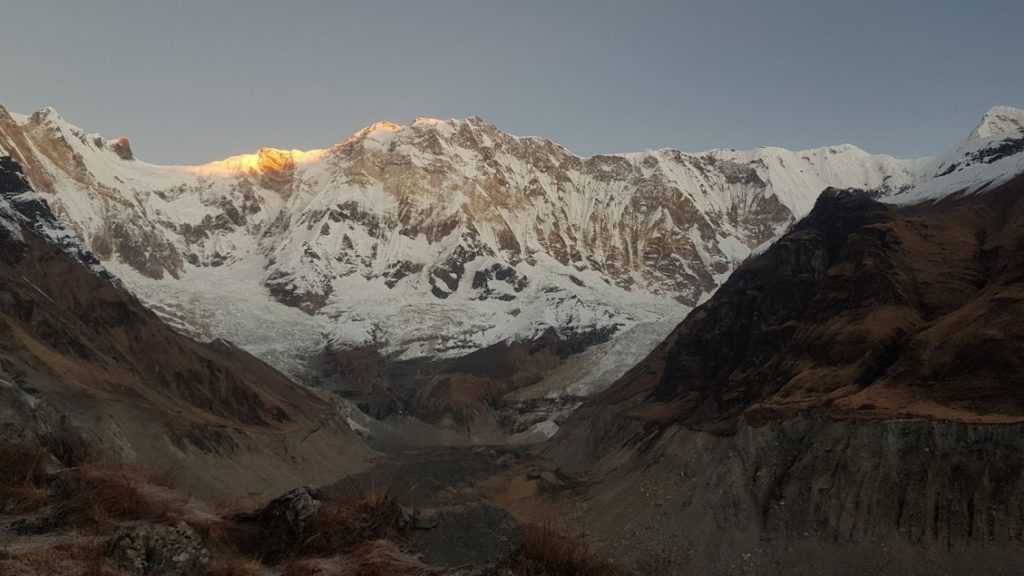
Highlights of Annapurna Base Camp Trek
- Enjoy the foods and culture of Gurung Villages
- On your way, you will explore Oak forests and Rhododendron forest
- Adventurous experience throughout your journey
- Explore the rural Nepalese lifestyle
- Taste local foods such as Daal-Bhat
- Beautiful view of Mt. Machhapuchre(Fishtail) and Mt. Annapurna
- The shadow of Mt. Annapurna falling in Annapurna Base Camp and close view of beautiful stars at night
Trek glance of Annapurna Base Camp Trek
- Arrival City: Kathmandu
- Departure City: Kathmandu
- Average Duration: 6 to 8 days
- Altitude: 4100m/ 13546ft
What is the best season for Annapurna Base Camp Trek?
The optimum time to walk to Annapurna Base Camp is in the shoulder seasons of April-May (Spring) or October-November (Autumn), which are pre-monsoon and pre-winter, respectively.
Depending on the altitude, the weather is somewhat hot during the day and freezing at night during trekking. There’s also a lower possibility of rain during this period, and you’ll want to obtain a string of clear days, which is ideal for trekking.
How difficult is the Annapurna Base Camp Trek?
The Annapurna Base Camp trek is rated “Moderate-Difficult” by us. The ABC journey is classified as Moderate-Difficult for two main reasons.
The first consideration is the distance. Over ten days, the trekker travels a total distance of 67 kilometers. This contains three days with distances of more than 10 kilometers, the largest of which being 15.5 kilometers from ABC to Bamboo.
Then there’s the sheer elevation increase and decrease. Starting at a little over 7,300 feet at Komrong, the trip quickly ascends to 13,550 feet at the ABC. The path climbs approximately 4,000 feet in height over 10 kilometers on the fifth day of the expedition. This is something you should consider while planning your trek.
How to get to the trailhead of Annapurna Base Camp Trek?
The first thing when you arrive at Kathmandu will be heading towards Pokhara. There are many ways to reach Pokhara. You have multiple options to travel to Pokhara. We recommend you take your journey by flight because you will be consuming most of your time as it takes only 30 minutes.
You can also choose your journey by bus or jeep which will take you to Pokhara within 6 to 7 hours. Once you have reached Pokhara you will be moving forward towards Ghandruk. Ghandruk has been one of the best places through which you can go to the Annapurna Base camp. The only way towards Ghandruk will be by car or jeep which will take around 2 hours.
Annapurna Base Camp Trek Permit
- For foreigners, the ACAP try permission charge is 3,000 NPR (about USD 30).
- For SAARC nationals, the ACAP entrance permit charge is 200 NPR.
- Permit for TIMS: 1,000 NPR (about $10 USD)
Mardi Himal Trek
Mardi Himal has been considered one of the hidden gems that are located in the Annapurna region. The Mardi Trek is one the worthiest treks on this list of beautiful short treks in Nepal. You can enjoy and have a charming view of Annapurna Mountain in a 360-degree view. The Mardi Himal Trekking excursion brings you to Mardi Himal’s base camp, which is nestled between Mardi Himal and Machhapuchhre, also known as Fish Tail Mountain.
You can see the sights sans the throng on the Mardi Himal Trek. Expect genuine teahouses, beautiful rhododendron woods, and some of the best Annapurna Mountain Range vistas. Mardi Himal, Machhapuchhre, Annapurna South, and Hiunchuli are among the giants you’ll encounter.
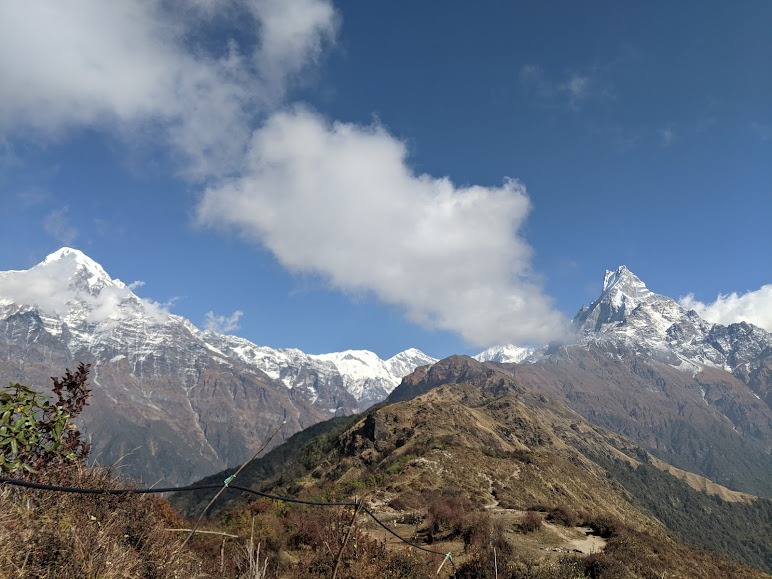
Highlights of Mardi Himal Trek
- Visiting various places in Pokhara
- Enjoining the various routes throughout your journey such as forests, waterfalls, rivers
- You will be experiencing different ecosystems such as plant and animal lives and the lives of people living in a rural area
- Get to know more about the local villages and the different kinds of religions living there.
- You will also be interacting along with the villagers where you will be experiencing their lifestyle
Trek glance of Mardi Himal Trek
- Arrival City: Kathmandu
- Departure City: Kathmandu
- Average Duration: 6 to 8 days
- Altitude: 55887m/17060ft
How difficult is the Mardi Himal Trek?
The Mardi Himal trek is becoming increasingly popular due to its breathtaking scenery. The journey is a shorter one, lasting 5 to 10 days, and is appropriate for even inexperienced trekkers.
Because it is a teahouse trek, most trekkers consider it to be a reasonably simple route. It is also considered easy because it is one of the shortest treks and the trail does not go to any severe terrain. Beginner trekkers, on the other hand, consider it a moderately tough trek. Because of the strenuous lengthy hikes and steeper ascents.
On the slopes of Mardi Himal, you walk for 5 to 6 hours each day. However, the rest stops in between treks make it a little easier. Even though you will be hiking upwards, altitude may not be an issue. This is because relaxation intervals have been carefully planned.
This trek takes you to a height of 4,500 meters. The chilly breeze caresses your aching muscles as you ascend to the Mardi Himal viewpoint. Then you realize that the ascent was well worth it because of the spectacular views of the Alps. In comparison to other mountain climbs in Nepal, this is a very simple walk.
How to get to Mardi Himal Trek?
Mardi Himal Trek will be able to enter through Pokhara. If you are arriving in Kathmandu then you may travel to Pokhara by car, jeep, or even by bus, which will take you to Pokhara within 6 to 7 hours. The other means of transportation can be through the air where we can provide you with all the facilities by flight which can make your journey shorter.
Traveling through the air can lead you to Pokhara in 30 minutes. Once you have reached Pokhara to start your trek journey you will have to travel towards Phedi which will take half an hour if you take your private vehicle.
Best Seasons for Mardi Himal Trek
There are four different seasons in the Annapurna Region, as well as the rest of Nepal. Summer, Autumn, and Winter are the four seasons. The most popular months for walking this Annapurna classic are March to May and October to November. It must be stated that each trekking season has its unique enthusiasm and environment for trekkers.
Mardi Himal Trek Permit
- For foreigners, the ACAP try permission charge is 3,000 NPR (about USD 30).
- For SAARC nationals, the ACAP entrance permit charge is 200 NPR.
- Permit for TIMS: 1,000 NPR (about $10 USD)
Khopra Ridge Trek
The Khopra trek, also known as the Khopra Ridge Trek, the Khopra Danda Trek, or the Khayer Lake Trek, is a famous off-the-beaten-path trek and one of the short treks in Nepal in the Annapurna area. The Dhaulagiri (8,167m), Nilgiri (7,061m), Bhara Shikhar (7,647m), Annapurna I (8091m), Machhapuchhre (6,997m), and many more peaks are seen from Khopra.
Furthermore, this is a wonderful trek track for trekkers who have a very short length of time to trek, approximately 10 days but desire to travel in a calm location, this is the ideal alternative. The major destination, Khayer Lake, is 4500 meters (14763 feet) above sea level and is considered sacred by Hindus.
A Khayer lake trek, located just by leap on the Annapurna range, is a challenging trek in and of itself, especially in the last part. During this walk, the ever-smiling faces of local people, their customs, and the thick rhododendron forest make you extremely pleased. Rhododendron blooms bloom between March and April.
Highlights of Khopra Trek
- Enjoy the view of Phewa Lake in Pokhara
- Try different cuisines near Lakeside
- Beautiful views in Khopra Ridge including sunrise and sunset
- Enjoying your trek inside rhododendron forest and other forests that involve green trees
- Get to know the past of the Gurung community and visit the Gurung museum
Trek glance of Khopra Ridge Trek
- Arrival City: Kathmandu
- Departure City: Kathmandu
- Average Duration: 7 to 9 days
- Altitude: 3640m
How difficult is the Khopra Ridge Trek?
The Khopra Ridge Trek has a very minimal altitude increase. It will be quite simple to adjust to the altitude variations. You may most certainly face some difficult uphills and downhills while walking in hilly locations. In Ulleri, you’ll climb more than 3000 stairs.
The Annapurna Khopra ridge trek is somewhat challenging due to little altitude increases and many uphills and downhills. The Annapurna Khopra Ridge trip, like any other moderately tough trek, requires considerable physical training. A couple of warm-up treks will also aid you in completing this adventure.
What is the best time for the Khopra Ridge Trek?
The optimum seasons for completing the Annapurna Khopra Ridge trip are autumn (September, October, and November) and spring (March, April, and May). In these two seasons, the number of trekkers who come to accomplish this journey is larger than in other seasons. During these seasons, the mornings are frequently clear. As a result, you may enjoy some spectacular vistas of the Annapurna region’s mountains.
This journey is popular in the fall and spring seasons because of the mild weather and minimal quantity of precipitation. Because of the trek’s low altitude, it’s also a great place to visit in the winter. The Annapurna Khopra trip is not as chilly as another high-altitude trek in the winter. In the winter, the vistas of the mountains are the most breathtaking. You may enjoy the Annapurna Khopra Ridge in the summer as well if you prepare for the occasional showers and slick pathways by having solid hiking equipment to keep the rain at bay.
How to get to Khopra Ridge Trek?
Similar to other trekking you first have to arrive at Pokhara. You can head to similar other trekking you first have to arrive at Pokhara. You can head towards Pokhara through different means. We would like to recommend going to Pokhara by road can be one of the best journeys throughout your holiday as you can enjoy the views across the roads within 6 to 7 hours.
But if you are planning to fly to Pokhara then you can reach there within 25 to 30 minutes. To start your trek, you have to travel towards Syauli Bazaar. You will need to travel for almost 2 hours to get there. You will be starting your trek from Syauli Bazaar and heading towards Ghandruk.
Permit for Khopra Ridge Trek
- For foreigners, the ACAP permission charge is 3,000 NPR (about USD 30)
- For SAARC nationals, the ACAP entrance permit charge is 200 NPR.
- Permit for TIMS: 1,000 NPR (about $10 USD)
![]() Ghorepani Poon Hill Trek
Ghorepani Poon Hill Trek
Ghorepani Poon Hill Trek, which is also known as one of the classic and short treks of Nepal where you can get various opportunities such as snow-capped mountains where the sun shines from it. It is to be said the “difficult roads lead to beautiful destination” so the steps towards Poon Hill may get tough at the beginning but the views that you are going to admire are worthy.
The Poon Hill trek is one of the most popular in the Annapurna Sanctuary since it is one of the simplest. It’s an excellent path for beginner trekkers and those who just want to have a taste of Nepali trekking. The walk can be completed in three or four days, and the route is well-marked.
There are several guesthouses and restaurants along the way, as well as a large number of people, so there is no need to worry about getting lost or not being able to find a place to stay or eat. The Poon Hill trek is a wonderful way to acclimate before tackling one of the more difficult treks like the Annapurna Circuit or the Annapurna Base Camp trip.
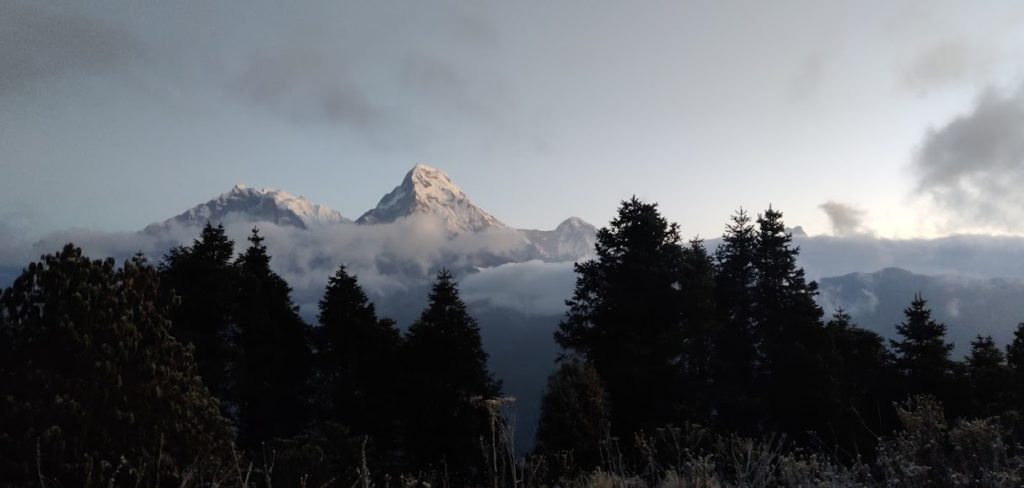
Highlights of Ghorepani Poonhill Trek
- One of the most well-known short treks in Nepal—and with good reason.
- You’ll be rewarded with sweeping vistas of Dhaulagiri if you climb 3,381 stairs.
- Spend the night at one of the cozy teahouses along the trail.
- Views of alpine lakes, farms, and mountains, notably Annapurna South
Trek glance of Ghorepani Poonhill Trek
- Arrival City: Kathmandu
- Departure City: Kathmandu
- Average Duration: 3 to 5 days
- Altitude: 3210m
How difficult is the Ghorepani Poonhill Trek?
Poonhill Trek is a fairly demanding excursion that requires little physical preparation or trekking experience. However, any difficulties or delays en route must be met with both physical and mental determination.
Travelers who want to make the journey simpler should begin by exercising before setting out on their adventure. Before the journey, do some aerobic workouts and day walks with some uphill/downhill climbs to prepare yourself for the changing path on the hiking trail.
What is the best season for Ghorepani Poonhill Trek?
The walk may be done at any time of year, although it is simpler when the trails are clear of rain or snow.
The ideal months to go on the Poon Hill walk are March through May and September through November. The weather is clearer and the temperature is mild throughout these months, with just the mornings and nights being cool, leaving the days clear for spectacular mountain vistas.
How to get to Ghorepani Poonhill?
The first thing when you arrive at Kathmandu will be heading towards Pokhara. You can head towards Pokhara through different means. We would like to recommend going to Pokhara by road can be one of the best journeys throughout your holiday as you can enjoy the views across the roads within 6 to 7 hours. But if you are planning to fly to Pokhara then you can reach there within 25 to 30 minutes. To start your trek, you have to travel toward Nayapul which will take you less than 2
hours.
Ghorepani Poonhill Permit
- For foreigners, the ACAP try permission charge is 3,000 NPR (about USD 30).
- For SAARC nationals, the ACAP entrance permit charge is 200 NPR
- Permit for TIMS: 1,000 NPR (about $10 USD)
![]() Langtang Valley Trek
Langtang Valley Trek
The picturesque Langtang area of Nepal is the nearest National Park to Kathmandu, and it can be reached without taking any internal flights making it one of the most beautiful short treks in Nepal. The region is known for its gorgeous cedar trees and flowers, as well as breathtaking vistas of soaring Himalayan peaks such as the gigantic Shishapangma, one of the 8000-meter summits, Manaslu Massif, Ganesh, Langtang, and Jugal Himal.
Langtang is known as the world’s most beautiful valley, and our journey includes an incredible first few days getting to the valley via the Tamang Heritage Trail. The Tamang path was established in 2004 and is still relatively new. It is a trip back in time that provides a very authentic and traditional experience for everyone who walks it.
Because the Tamang Heritage Trail is calmer than the more well-known Langtang Valley leg of our walk, you’ll see significantly fewer people. The infrastructure on the Tamang trail isn’t as well developed as it is in the main valley, Annapurna, or Khumbu regions during the first few days, but if you want a beautiful experience with raw natural beauty while spending time with the local communities, this trek is the perfect blend of old and new and adventure for you.
Highlights of Langtang Valley Trek
- One of the most gorgeous valleys on the planet.
- The ideal location for short treks in Nepal.
- Pass through beautiful woodlands, high alpine meadows, and yak pastures on your way to the summit.
- Landscapes with a variety of plants.
- In Kyanjing Gompa, a visit to the local cheese factory is made.
- At the end of the trek, take in panoramic vistas of large open valleys.
- In the Himalayas, immerse yourself in the rich cultural exploration of the locals.
Trek glance of Langtang Valley Trek
- Arrival City: Kathmandu
- Departure City: Kathmandu
- Average Duration: 5 to 7 Days
- Altitude: 3800m
How difficult is the Langtang Valley Trek?
The Langtang trek is a moderately demanding walk with stunning views of the mountains and glaciers. The Langtang walk offers a serene hiking experience, with sceneries depicting the people’s traditional way of life as well as several historic Buddhist temples.
Because it is a short trip to the north of Kathmandu, the Langtang trek is graded easy to moderate. It is the most accessible trek to Kathmandu Valley, with the greatest views of the high peaks and stunning valley views.
What are the best seasons for Langtang Valley Trek?
The greatest time to trek in Langtang is in the autumn. The weather is mild and consistent from September until mid-December. Trekking during this season allows you to walk under the beautiful blue sky, breathe fresh air, and witness great mountain vistas.
How to get to Langtang Valley?
Trek to Langtang Valley will start from Sybrubesi where you can travel only by road which is 120km far from Kathmandu. As is it the only option to reach there it takes you 7 to 8 hours to reach there. There are no difficulties along with your road trip but once you have reached the Sybrubesi the road will start getting worse. Therefore, we recommend you avoid traveling in the monsoon because the condition of the roads will get extremely bad.
Langtang Valley Trek Permit
- Foreign visitors to Langtang National Park must pay a charge of 3,000 NPR plus 13% VAT, totaling 3,390 NPR (about $34).
- The entrance cost to Langtang National Park for SAARC citizens is 200 NPR.
- Permit for TIMS: 1,000 NPR (about $10 USD)
Lower Mustang Trek
The Lower Mustang Trek is a collection of various itineraries based on the historic Himalayan Kingdom located in Nepal’s northern central region near the mouth of the Kaligandaki River. The upper Mustang is divided into two sections. The southern and northern parts, where the Tibetan people’s languages, culture, and customs are similar.
This region is regarded as one of Nepal’s most intriguing and beautiful locations. The entire region has an isolated and mysterious sense about it, which enchants and inspires people. Lower Mustang Trekking takes you through the high-altitude desert landscape, ascending in and out of Kali Gandaki’s massive-sided valley.
It can be customized according to your time frame making it one of the unique short treks in Nepal. The gorge through which the Kali Gandaki River flows is the deepest in the world in certain areas. Some of Nepal’s oldest Buddhist monasteries may be found here, as well as historic and remote villages with charming white-painted buildings.
Highlights of Lower Mustang Trek
- Tibetan monarchies and Buddhist culture
- Ancient roads lead towards Mustang across the bridge of Kali Gandaki river
- Muktinath is one of Nepal’s holiest Hindu pilgrimage places.
- Mesmerizing views of different snowcapped mountains such as Dhaulagiri and Annapurna
Trek glance of Lower Mustang Trek
- Arrival City: Kathmandu
- Departure City: Kathmandu
- Average Duration: 8 to 10 days
- Altitude: 3710m
How difficult is Lower Mustang Trek?
Trekking can be difficult and tiring. So, for a difficult challenge, you could require some physical training and expertise. Nepal Even though we have more hard routes in various regions than Everest, trekking at Everest Base Camp does not require prior expertise or extraordinary fitness. Trekking in the Himalayas always brings us to high elevations and steep trails.
To maintain your strength, you might request adequate rest and acclimatization. Mountains are never conquered in a single day. In our itineraries, we always provide relevant information. However, some types of training, such as jogging, skipping, and other exercises will undoubtedly be advantageous on such difficult roads.
What is the best season for Lower Mustang Trek?
The ideal seasons for hiking and mountaineering in Nepal are autumn (September – November) and spring (March-May). During these seasons, the weather is typically clear and the temperature is mild, allowing for spectacular vistas with no obstructions. Beautiful flowers, plants, and unique creatures greet you in the spring.
During these months, it’s best to go for a walk. Summer (June-August) and winter (November-March) (December – February). Even though summer brings significant monsoon rains, the trails in Mustang, Dolpo, and Nar-Phu valleys are considerably clearer because they are rain-show locations. Trekking on Everest, Langtang, Annapurna, and Tibet is always better in the winter.
How to go to Lower Mustang?
If you are willing to head towards Lower Mustang Trek, then you must go through the roads of Jomsom, which is the entrance point of your journey. You can get multiple options on your journey if you want to drive there or take a flight. Flights can be very easy when you go trekking but there are no airports in Jomsom to which you need to take flights twice.
First, you will need to fly from Kathmandu to Pokhara which will take 25 to 30 minutes. Second, you will need to take a short trip from Pokhara to Jomsom. Another choice can be through drive where you need to start your journey from Kathmandu to Jomsom. The roadway will take 10 to 12 hours until you reach there.
Lower Mustang Permit
- For foreigners, the ACAP try permission charge is 3,000 NPR (about USD 30).
- For SAARC nationals, the ACAP entrance permit charge is 200 NPR.
- Permit for TIMS: 1,000 NPR (about $10 USD)
Gosaikunda Lake Trek
Gosaikunda Lake (4380m) is a Hindu pilgrimage destination recognized for its religious importance. This treks you to the beautiful religious holly lake with the beautiful mountain range making it one of the most peaceful short treks in Nepal. Hindus throng the spot around Janai Purnima in August. The first few days are spent hiking through the woods until you reach Cholang Pati, where you can see the towering Ganesh Himal, Langtang Himal, and Annapurna in the distance. Spend the night in one of Lauribinayek’s tea houses, then get up early the next morning to climb up to the lakes. Return to Dhunche and Kathmandu in the following days.
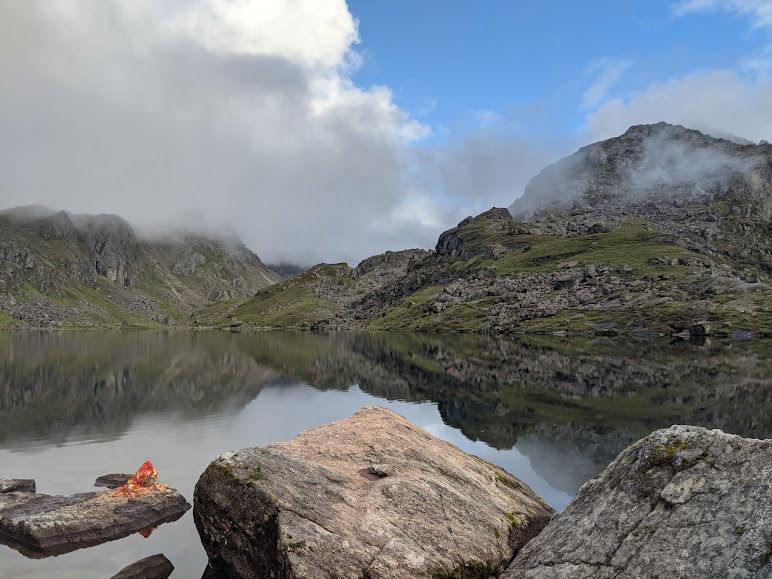
Highlights of Gosaikunda Lake Trek
- Get to know about the traditional villages and monasteries
- The eye-catching view of Langtang, Ganesh, and other mountains
- Discovering the Langtang National Park where you can get to know about the wildlife
- Trekking trails through dense forest
Trek glance of Gosaikunda Lake Trek
- Arrival City: Kathmandu
- Departure City: Kathmandu
- Average Duration: 6 to 8 days
- Altitude: 4380m/ 14370ft
How difficult is the Gosaikunda Lake Trek?
The Gosaikunda trek is moderate and easy. As a result, regardless of your hiking expertise, you may sign up for it. There are periods when the route becomes steeper and more difficult, but for the most part, it has a modest angle of ascent and is simple to ascend. You will, however, require a high level of physical endurance, as the journey demands you to walk for around 5-7 hours every day on average.
Because the trip takes you over 3000 meters, altitude sickness is a possibility. However, if you ascend gently and properly acclimate, you should be OK for the duration of your journey.
If you still succumb to it, don’t ignore the signs and symptoms and descend to a lower height where the air is sufficient.
What is the best season for Gosaikunda Lake Trek?
The best seasons to visit Gosaikunda are autumn and spring. Because of the weather’s unpredictability, it’s best to visit between the end of February and the beginning of June, and from the beginning of September to the end of December.
You can also travel during July and August, however owing to the rain, the view will be hazy.
How to get to Gosaikunda Lake?
Trek to Gosaikunda Trek will be starting from Sybrubesi where you can travel only by road which is 120km from Kathmandu. As is it the only option to reach there it takes you 7 to 8 hours to reach there. There are no difficulties along with your road trip but once you have reached the Sybrubesi the road will start getting bumpy.
Gosaikunda Lake Trek Permit
- Foreign visitors to Langtang National Park must pay a charge of 3,000 NPR plus 13% VAT, totaling 3,390 NPR (about $34).
- The entrance cost to Langtang National Park for SAARC citizens is 200 NPR.
- Permit for TIMS: 1,000 NPR (about $10 USD)
Ruby Valley Trek
One of the most stunning homestay short treks in Nepal is the Ruby Valley Trek. It is a far less difficult and time-consuming journey than any other high-altitude trek in Nepal. This trip, however, has a variety of geography, culture, and wildlife along the route, as well as the most beautiful and up-close views of the Ganesh Himal, Langtang, and Manaslu peaks.
In the spring, the Ruby Valley is adorned with a variety of gorgeous blooms, including the Nepalese national flower, Rhododendron, as well as other plants such as Pines and Orchids in the backdrop. An epic journey through Ruby Valley to the most stunning places in the Himalayas offers the most beautiful views and a Himalayan landscape, but you’ll also learn about people of various ethnicities, lifestyles, and traditions, particularly Gurung and Tamang people when visiting those fascinating villages during the trip. Similarly, the renowned dawn view of the Himalayas can be seen from practically every community in the region.
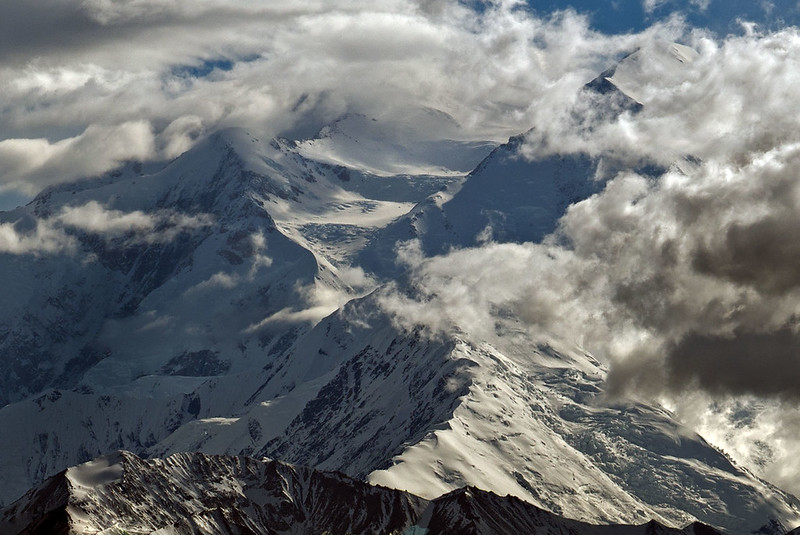
Highlights of Ruby Valley Trek
- Beautiful views of different mountains covered in snow such as Manaslu, Ganesh Himal, and Langtang Mountains
- Journey over oak forests, cultivable fields, bamboo forests, and hills
- Observe mesmerizing long bridges, calm and peaceful rivers, waterfalls
- Ruby Valley’s untrodden route leads to lonely and secret valleys.
- Exploring the Gurung and Tamang cultures and lifestyles.
Trek glance of Ruby Valley Trek
- Arrival City: Kathmandu
- Departure City: Kathmandu
- Average Duration: 6 to 8 days
- Altitude: 3850m
- Difficulty: Moderate
- Best Seasons: March to May and September to December
How difficult is Ruby Valley Trek?
The Ruby Valley Trek is a moderate to easy trek with a maximum elevation of 3,842 meters at Pangsang Pass. During the journey, you will be walking for a max of 7 hours and a minimum of 3 hours. You’ll be walking for about 6 hours every day on average. To complete this trek, you must be physically fit. It is appropriate for both inexperienced and expert trekkers.
What is the best season for Ruby Valley Trek?
Autumn is one of the greatest times to visit Nepal for this journey. Autumn (Fall) is a dry season with clear blue skies and moderate temperatures, making it ideal for trekking. As a result, this is the best time to visit any of Nepal’s treks, including Ruby Valley. However, this season brings a large number of tourists to popular treks such as Everest and Annapurna regions.
How to go to Ruby Valley Trek?
There are several options for getting around it. The walk begins at Syabrubesi, about 150 kilometers from Kathmandu. Syabrubesi also serves as the starting point for the renowned Langtang Valley trek. This trip may also begin from Dundure Khola (135km) through Dhading Besi from Kathmandu. Many people begin their walk at Bhalche, Nuwakot, and travel across Sing La Pass (4045m). Daily local buses are available to Bhalche, Syabrubesi, and Dundure Khola which is connecting the drive via Dhading Besi. On the first day, we started from Arukhet and followed the Manaslu route.
Ruby Valley Trek Permit
Since Ruby Valley is neither a Conservation Area nor a National Park, this trek does not require special permission. Because the TIMS Card is required for all treks in Nepal, it is also required for the trekkers. If you are starting a trek or concluding one in Syabrubesi, you will need to obtain a Langtang National Park entrance permit, which can be purchased in Dunche or Kathmandu.
- Foreign visitors to Langtang National Park must pay a charge of 3,000 NPR plus 13% VAT, totaling 3,390 NPR (about $34).
- The entrance cost to Langtang National Park for SAARC citizens is 200 NPR.
- Permit for TIMS: 1,000 NPR (about $10 USD)
Pikey Peak Trek
The Pikey Peak is one of Nepal’s most popular short treks in Nepal for both tourists and Nepalese trekkers. This trip is becoming more popular because of the easy trekking, the greatest view of the Himalayas from Dhaulagiri in the west to Mt. Kanchenjunga in the east, including Everest, convenient local transportation, and fewer visitors with very basic accommodation.
The Pikey Peak (4060m) gives the greatest dawn and sunset panoramic views of Everest and other Himalayan ranges with deep green valleys when the weather is clear. This trek is ideal for everyone, especially those who wish to enjoy the greatest views of Everest and beautiful landscapes in a short amount of time. It not only provides spectacular views but also provides an opportunity to learn about Sherpa culture. Visiting a tiny Sherpa farming hamlet, Buddhist monasteries, and a rhododendron forest might be a good mix of Nature and cultural discovery.
Highlights of Pikey Peak Trek
- View Mount Everest from the beautiful view
- View a vast length of the Himalayan range
- Discover the lower Everest region, which most tourists overlook
- Learn and experience more about Sherpa culture
Trek glance of Pikey Peak Trek
- Arrival City: Kathmandu
- Departure City: Kathmandu
- Average Duration: 7 to 9 days
- Altitude: 4065m
How difficult is Pikey Peak Trek?
You might be concerned about the difficulty of the Pikey Peak trek. If that’s the case, Pikey Peak is neither a tough nor a demanding trek. Because of its lower height, it is accessible to the majority of people. You can accomplish it fairly comfortably if the trekkers/hikers can walk 5-6 hours every day. However, ups and downs are typical. The highest height gained in this journey is 4065 meters, which is a vista; nonetheless, due to the moderate elevation, the trek is not challenging.
What is the best season for Pikey Peak Trek?
Pikey Peak Trek is best done between September and December in the fall and February and June in the spring. These seasons are recognized for their beautiful weather and breathtaking scenery. Autumn is a happy time in Nepal since the country’s most important event falls around this time. Similarly, spring is a happy period, with a variety of flowers blooming around the country.
In Nepal, the monsoon delivers torrential rains, posing a risk of landslides and flooding. Furthermore, the route will be slick, and leeches will encroach on you as you go through the jungle. However, for dedicated botanists, this season may be ideal, since the entire trekking track would be covered with thick flora.
The bitterly cold temperatures of winter may not be ideal for all trekkers. If you plan on trekking Pikey Peak in the winter, make sure to verify the availability of tea houses at higher elevations. People flee to lower elevations to avoid the cold and snow, therefore the tea shop is frequently closed.
How do I get to Pikey Peak?
To enter the beautiful destination, Pikey Peak trek you will need to start your trek from Dhap. The road towards Dhap can be traveled through a roadway. Your journey to Dhap from Kathmandu will be full of eye-catching sites as you will be covering the routes of the Sunkoshi River and Okhaldhunga. Besides roadways, you are provided with a choice as well in which you will be using airways that will land you in Phaplu. The time duration to reach Phaplu will be about 25 to 30 minutes. If you have limited time and want to complete your trip by flight go for it.
Pikey Peak Permit
- Foreign visitors to Sagarmatha National Park must pay a charge of 3,000 NPR plus 13% VAT, totaling 3,390 NPR (about $34).
- For SAARC nationals, the entrance cost to Sagarmatha National Park is: NPR 1,500
- From October 1, 2018, the Khumbu Pasang Lhamu Rural Municipality of Solukhumbu district has imposed a Rs 2,000 (about $20) entrance charge on any foreigner entering the rural municipality, replacing the TIMS permit: 1,000 NPR (roughly $10).
- The fee for the Khumbu Pasang Lhamu Rural Municipality must be paid at the Lukla Check Post.
Ama Dablam View Trek
Ama Dablam view trek is one of the most beautiful and short treks in Nepal which is located in the Everest region. The Ama Dablam View trek may be the shortest in the region but it is the most exciting trek according to its length. Ama Dablam View trek has been considered one of the most delightful treks with and lower altitude. Compared to other treks this trek gives you the sensation and experience of different forests, lakes, and villages.
Highlights of Ama Dablam View Trek
- Trekking into the beautiful Khumbu area.
- Visiting the world-famous Sherpa monastery in Tengboche
- An exciting and spectacular flight to Lukla’s Tenzing Hillary Airport, Khumbu’s only airport.
- Ama Dablam Base Camp visit.
Trek glance of Ama Dablam View Trek
- Arrival City: Kathmandu
- Departure City: Kathmandu
- Average Duration: 8 to 10 days
- Altitude: 4600m
How difficult is Ama Dablam View Trek?
Ama Dablam is a Buddhist temple in Ama Dablam, Difficulty levels range from simple to moderate to difficult. The difficulty level varies from moderate to challenging. On the beautiful ridge between Camp I and Camp III, there are various short and steep parts, as well as near-vertical ice and rock. Climbing to the top of High Camp-I is simple. The road from High Camp II to High Camp III is primarily covered in steep rocks, snow, ice glaciers, and other obstacles. The last ascent to the summit is a lengthy and arduous ascent via the snow and ice glacier. It necessitates both physical and mental toughness.
Which is the best season for Ama Dablam View Trek?
Climbing Ama Dablam is best done during one of two climbing seasons.
Spring (Mid-April-May) – Because big adventure firms are concentrated on the Everest trip, there are few climbers during the spring season. Climbers looking for fewer teams and climbers on the route should go in the spring.
Autumn (September – November) – Climbers flock to the mountains in the autumn. From mid-October through the end of November, you can expect a lot of teams to be climbing.
How to get to Ama Dablam?
The best option to start your trek is by taking a flight from Kathmandu to Lukla. While running through your journey the first stop on your trek will be Phakding where you will be spending your night. The second day of the trek will be very easy as your next stop will be Namche Bazar where the roads are excellent.
Ama Dablam Trek Permit
- Foreign visitors to Sagarmatha National Park must pay a charge of 3,000 NPR plus 13% VAT, totaling 3,390 NPR (about $34).
- For SAARC nationals, the entrance cost to Sagarmatha National Park is: NPR 1,500
- From October 1, 2018, the Khumbu Pasang Lhamu Rural Municipality of Solukhumbu district has imposed a Rs 2,000 (about $20) entrance charge on any foreigner entering the rural municipality, replacing the TIMS permit: 1,000 NPR (roughly $10).
- The fee for the Khumbu Pasang Lhamu Rural Municipality must be paid at the Lukla Check Post.